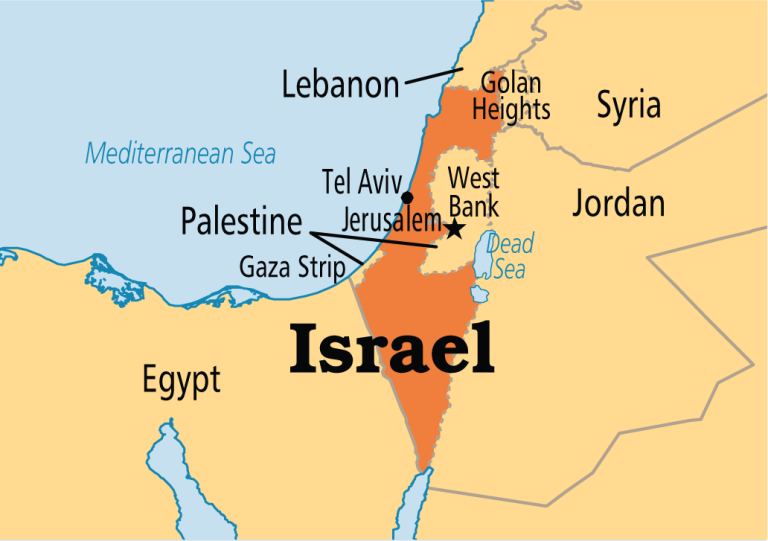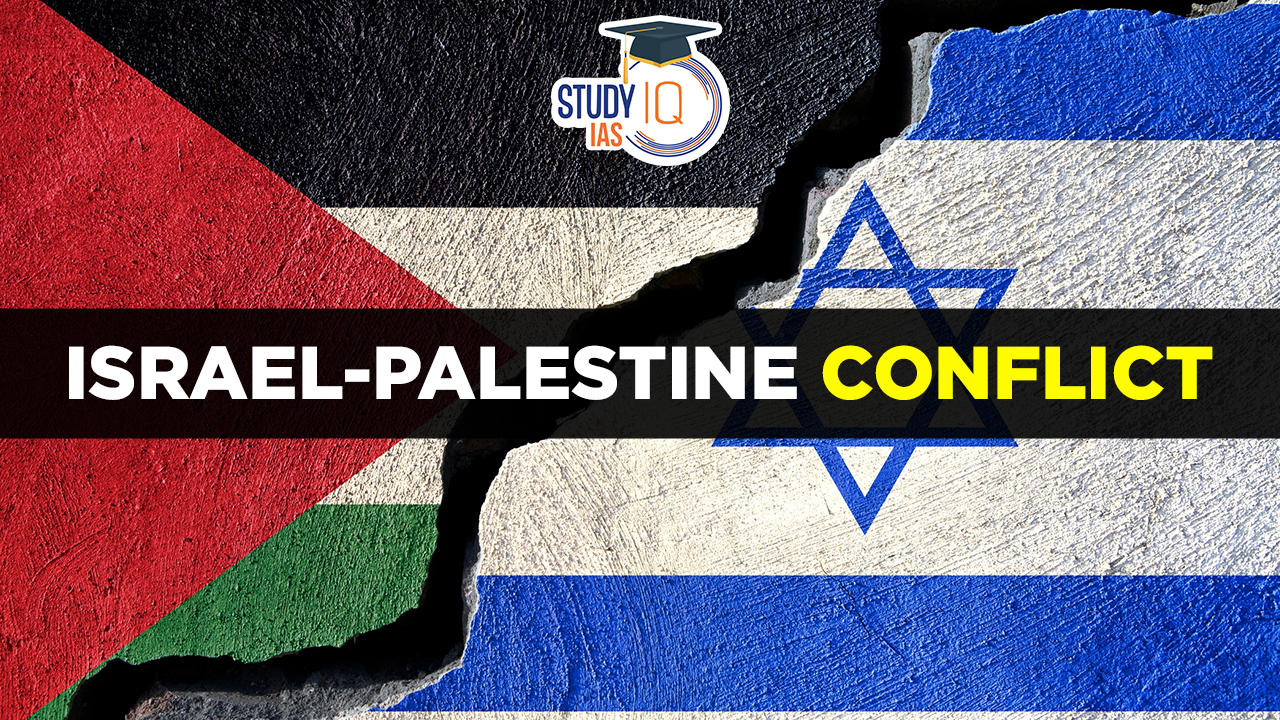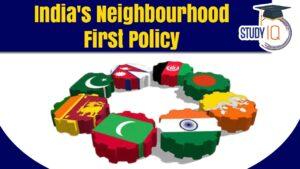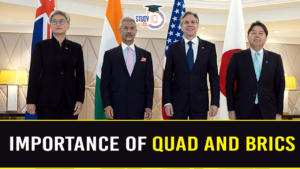Table of Contents
Israel-Palestine Conflict: Latest Updates
On October 7, 2023, Hamas leader Mohammed Deif announced the start of Operation Al-Aqsa Flood, a large-scale offensive against Israel. This sparked the worst flare-up in the Israel-Palestine conflict in recent years. Israel declared a state of war in response and asked Palestinians to leave the Gaza Strip. India also launched Operation Ajay to help Indian nationals evacuate from Israel. Check here all about the Israel-Hama War 2023 in detail.
Geographical Locations of Israel and Palestine
- Israel: It is a country in the Middle East, located at the eastern end of the Mediterranean Sea.
- It is bounded to the north by Lebanon, to the northeast by Syria, to the east and southeast by Jordan, to the southwest by Egypt, and to the west by the Mediterranean Sea.
- Jerusalem is the seat of government and the proclaimed capital.
- Israel is the world’s only Jewish state.
- Palestine: It is an area of the eastern Mediterranean region, comprising parts of modern Israel and the Palestinian territories of the Gaza Strip (along the coast of the Mediterranean Sea) and the West Bank (west of the Jordan River).
- It is also known as the Holy Land and is held sacred among Jews, Christians, and Muslims.

Israel-Palestine Conflict
- The Israel-Palestine conflict is one of the world’s longest-running and most controversial conflicts.
- It is a conflict between two self-determination movements, the Jewish nationalist project and the Palestinian nationalist project, in the same territory.
- The land to which Jews and Palestinians lay claim was under the Ottoman Empire and then the British Empire in the early 20th century.
- Palestinian people, the Arab people from the same area, want to have a state by the name of Palestine in that area.
- The conflict between Israelis and Palestinians is over who gets what land and how it’s controlled.
- In the 20th century, Jews fleeing persecution in Europe wanted to establish a Jewish state on the land they considered their ancient homeland. The Arabs at the time resisted, saying the land was theirs. The land at the time was called Palestine.
Timeline of Israel-Palestine Conflict
- 1917: In the Balfour Declaration, the United Kingdom which controlled Palestine after World War I declared its support for the establishment of a “national home for the Jewish people” in Palestine. Arabs resisted it, which led to violence.
- 1922: 75,000 Jews emigrated to Palestine between 1922-26 and some 60,000 Jews emigrated in 1935. Palestinian Arabs demanded the UK to halt Jewish emigration, but the UK ignored such calls.
- 1923: In 1923, the British Mandate for Palestine came into effect. The document was issued by the League of Nations. The Mandate gave the UK the responsibility for creating a Jewish national homeland in the region.
- 1936: 1936 after several rounds of violence between Jews and Arabs, the Peel Commission set up by the UK government recommended the partition of Palestine into Jewish and Arab states.
- 1947: In 1947, the UK referred the issue of Palestine to the UN. The UN gave a partition plan for independent Jewish and Arab states in Palestine. This was accepted by Jews but not by Arabs.
- 1948: In May 1948, Israel declared its independence. The Arab countries of Lebanon, Syria, Iraq, and Egypt invaded the newly-declared country immediately.
- When the war ended, Israel gained some territory formerly granted to Palestinian Arabs under the UN resolution in 1947.
- Egypt and Jordan also retained control over the Gaza Strip and the West Bank respectively. This territorial control remained in place till 1967.
- 1964: In 1964, the Palestine Liberation Organization (PLO) was formed as the national representative of the Palestinian people.
- 1967: In 1967, a six-day war occurred between Israel and Arab states. After the war, Israeli forces seized the Golan Heights from Syria, the West Bank & East Jerusalem from Jordan, and the Sinai Peninsula & Gaza Strip from Egypt.
- 1975: In 1975, the United Nations granted the PLO an observer status and recognized Palestinians’ right to self-determination.
Gaza Strip
- Gaza is one of the focal points in the Israeli-Palestinian conflict.
- It is bordered by Israel and Egypt on the Mediterranean coast.
- It is a small self-governing Palestinian territory that came under Israeli occupation after the 1967 Arab-Israeli War.
West Bank
- It is a landlocked territory near the Mediterranean coast of Western Asia, bordered by Jordan to the east and by the Green Line separating it and Israel on the south, west and north.
- The West Bank also contains a significant section of the western Dead Sea shore.
- Since 1967, it has been under Israeli occupation.
Why is the Israel-Palestine Conflict Still Not Resolved?
- Jerusalem: Both Israel and the Palestinians hold competing claims to the city. Israel, which occupied the formerly Jordanian-held eastern part in 1967, regards the whole of Jerusalem as its capital. The Palestinians insist on East Jerusalem as their future capital.
- Borders: There is no consensus as to how to draw the lines dividing the two proposed states. Both sides have fundamentally different ideas as to where the boundaries of a potential Palestinian state should be.
- Palestinians insist on borders based on ceasefire lines which separated Israel and East Jerusalem, the West Bank, and Gaza between 1949 and 1967.
- However, Israel has demanded an extended eastern border stretching up to the Jordan River.
- Refugees: A large number of Palestinians had to flee in the 1948 War. They and their descendants demand a right to return. Israel rejects this. The return of these people would end the demographic majority of Jews, ending the idea of Israel that’s both democratic and Jewish.
- Settlements: Since 1967, Israel has built about 140 settlements in the occupied West Bank and East Jerusalem. They are considered illegal by most of the international community, though Israel disputes this. According to Palestinians, all settlements must be removed for a Palestinian state to be viable.
- Political Division in Palestinians: The Palestinians remain politically divided between Fatah and Hamas, and therefore are unable to negotiate jointly. Further, Israel is unwilling to negotiate with the violent group Hamas.
- Current Scenario: Tensions escalate between Israel and Palestinians living in East Jerusalem, Gaza and the West Bank.
- Gaza is ruled by the Palestinian militant group Hamas, which has fought Israel many times. Israel and Egypt tightly control Gaza’s borders to stop weapons from getting to Hamas.
- Palestinians in Gaza and the West Bank say they are suffering because of Israeli actions and restrictions. Israel says it is only acting to protect itself from Palestinian violence.
What is the Solution of Israel-Palestine Conflict?
- Two-State Solution: The primary approach to solving the conflict is a so-called “two-state solution” that would establish Palestine as an independent state in Gaza and most of the West Bank, leaving the rest of the land to Israel.
- Though the two-state plan is clear in theory, the two sides are still deeply divided over how to make it work in practice.
- One-State Solution: The alternative to a two-state solution is a “one-state solution,” wherein all of the land becomes either one big Israel or one big Palestine. Most observers think this would cause more problems than it would solve.
Global Stand on Israel-Palestine Conflict
- 83% of global countries recognize Israel’s legitimacy and maintain diplomatic relations with it, but most are critical of Israel’s treatment of the Palestinians and the ongoing occupation of the West Bank.
- They believe that Israel’s continued control of the West Bank is an unlawful military occupation and that settlements violate the Fourth Geneva Convention.
- The Geneva Conventions(1949) and their Additional Protocols are international treaties that contain the most important rules limiting the barbarity of war.
- The Fourth Geneva Convention affords protection to civilians, including in occupied territory.
- The United Nations General Assembly, the UN Security Council, and the International Court of Justice continue to back the partition plan that advocates for a “two-state solution.” These multilateral forums have also condemned the Jewish settlements.
- While the US has voiced its support for the two-state solution the country has simultaneously maintained that Israel has a right to defend itself if it is attacked in deadly violence.
India’s Stand on Israel-Palestine Conflict
- Historically, India held the accolade of being the only major non-Arab, non-Muslim nation to back the Palestinian cause.
- In 1974, India recognised the Palestine Liberation Organisation (PLO) as the sole and legitimate representative of the Palestinian people.
- Later in 1975, the first PLO office was set up in New Delhi and an embassy was set up in 1980.
- In 1988, India became one of the first countries to recognise the newly established state of Palestine.
- India has now taken cognizance of Human rights violations done by Israel in Palestine.
- India believes in the 2-State Solution and supports the establishment of a sovereign independent and viable state of Palestine.
- India voted in favour of accepting Palestine as a full member of UNESCO in 2011.
- India has been at the forefront, backing “the right of Palestinians to self-determination” and supported Palestine’s inclusion as a ‘non-member Observer state’ at the UN in 2012.
- In 2014, India supported the UNHRC’s resolution to probe Israel’s human rights violations in Gaza. But in the next year, India abstained from voting against Israel in UNHRC.
- As a part of the Link West Policy, India has de-hyphenated its relationship with Israel and Palestine.
India’s De-Hyphenation Policy on Israel and Palestine
- India’s stance on the conflict has shifted from a four-decades-long pro-Palestine position to a careful balancing act, following the establishment of India-Israel diplomatic relations in 1992.
- The de-hyphenation suggests a tilt towards an ‘independent’ foreign policy wherein bilateral relations with Israel are based solely on its own merits, separate from its relationship with the Palestinians.
- This policy shift has been exemplified by India’s changed voting pattern at the UN, wherein in 2019, India backed Israel at the ECOSOC (Economic and Social Council) to deny observer status to a Palestinian organisation.
- India also abstained on a resolution demanding a probe into Israeli actions in the Gaza Strip at the UN Human Rights Council.
Way Forward
- The world at large needs to come together for a peaceful solution but the reluctance of the Israeli government and other involved parties has aggravated the issue.
- Thus, a balanced approach towards the Israel-Palestine issue would help to maintain favourable relations with Arab countries as well as Israel.


 India's Neighbourhood First Policy, Prin...
India's Neighbourhood First Policy, Prin...
 Importance of Quad and BRICS Group
Importance of Quad and BRICS Group
 Right to Education Act 2009, Article 21A...
Right to Education Act 2009, Article 21A...

















